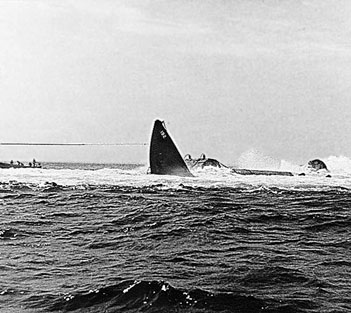A Risky Business: Safety On The High Seas
by Laurie Schreiber
|
On Jan. 23, 2000, at 11 a.m., the fishing vessel Two Friends sailed from Portland with a crew of three for a groundfishing trip in the Gulf of Maine.
Two days into it, rough weather hit. The captain completed the last haulback and headed home in the face of building seas. That afternoon, the lazarette bilge began to flood. Waves carried over the stern and onto the deck, downflooding into the engine room and the accommodations house. All hands soon realized the vessel would capsize. Preparing to abandon ship, they donned survival suits, but before they could deploy the liferaft, the vessel rolled. A crewman had his suit on, but was caught under the vessel and was never seen again. The captain had his suit partially on and died of hypothermia and drowning. Another crewman was rescued by Coast Guard helicopter at about 8 p.m.
On April 2, 2001, 15 fishermen died when the Arctic Rose sank in the Bering Sea. The 92-foot Seattle, Wash.-based fishing and processing vessel was out for the opening of the flathead sole season. The captains of the Arctic Rose and its sister ship, the Alaskan Rose, operating 10-15 miles away, had been in communication. Severe micro-weather conditions set in, producing confused seas and wind patterns. At 3:30 a.m., the Coast Guard received an EPIRB signal from the Arctic Rose but was unable to raise her. A message was sent to the Alaskan Rose and other vessels to be on the lookout. Due to communication problems caused by atmospheric and ground conditions as well as software error, the Alaskan Rose didn’t receive the message until several hours later.
|
 Despite the long list of accidents and fatalities at sea, the U.S.Coast Guard maintains that many casualties are probably preventable. Despite the long list of accidents and fatalities at sea, the U.S.Coast Guard maintains that many casualties are probably preventable.
Photo Alaska Marine Safety Education Association |
During their 36-hour search for survivors, the Alaskan Rose recovered seven immersion suits and several work vests from the debris field, and an inflatable liferaft right side up and empty. Only one body was recovered.
On Jan. 9, 2003, the 66-foot wooden shrimp trawler Capt. Adam, out of Tarpon Springs, Fla., was underway in the Gulf of Mexico when a fire broke out in the engine room. Attempts to extinguish the blaze failed and the fire burned out of control. Heavy black
continue
|
|
|
The Greatest Submarine Rescue In History
by Mike Crowe
|
In the spring of 1939, Lt. Oliver Naquin had come to the Portsmouth Navy Yard in Kittery, Maine to take command of a new submarine. Not unlike John Paul Jones, who had come to Kittery 164 years earlier to oversee the construction and outfitting of the Ranger, he was there for the completion and sea trials of the Navy’s newest fleet type submarine, the Squalus. Like others in the 59 man crew, Naquin had moved his wife and children to Portsmouth for the new assignment.
At the time, the Squalus was state-of-the-art engineering. She was 310 feet long, with a 27 foot beam and displacement of 1,450 tons. Power was from the two-stroke Fairbanks-Morse, 1600 hp diesel engine. This was an opposed piston engine; each of the 10 cylinders contained two pistons. The combustion space was formed by the two pistons arriving near the center simultaneously. There were two engine rooms with two engines in each.
The batteries, Exide Company Sargo type, had 126 cells each. Each cell weighed 2,000 lbs. There were two batteries in the forward battery and two in the after battery. The four 1600 hp engines gave her a 16 knot surface speed. Submerged, battery power produced 9 knots.
But engineering and a long list of built-in precautions, were not enough to dispel the fears of family members and some crew, that came from the illogic of being in the ocean in a heavy metal object that was effectively designed to sink. When a sub went down, the crew was all but presumed lost.
continue
|
 The bow of the Squalus rising out of control after being raised 243 feet by lift pontoons 15 miles off Kittery in May of 1939. A pontoon with air lines can be seen in the background. The small boat carrying Capt. Momsen is to the left. Seconds later it went down driving the aft section 20 feet into the muddy bottom in a tangle of lift cables and gear. The bow of the Squalus rising out of control after being raised 243 feet by lift pontoons 15 miles off Kittery in May of 1939. A pontoon with air lines can be seen in the background. The small boat carrying Capt. Momsen is to the left. Seconds later it went down driving the aft section 20 feet into the muddy bottom in a tangle of lift cables and gear. |
|
|
  
|
|

